All types of switches for home use - what they are and where they are used

When installing lighting, various types of switches are used, which are selected depending on the parameters of the lighting equipment and interior design. To choose the right model, you need to know what kind of switches are - what is the difference between them in terms of installation method, connection and principle of operation.
Content
Concealed and outdoor installation methods
The very first thing you have to decide is what kind of switch you need by the type of installation, which can be indoor or outdoor.
In the first case, installation is carried out inside the wall, for which holes of the appropriate size are cut out in it. This type of device is used most often, since most of the wiring is laid in a hidden way.
Outdoor switches are used either in wooden houses, in which the wiring is most often made of an open type, or when lighting devices are laid according to a temporary scheme - in this case, in order not to cut the walls, wires are laid on their surfaces.
In terms of design, flush-mounted switches are more attractive because only the front is visible on the wall.
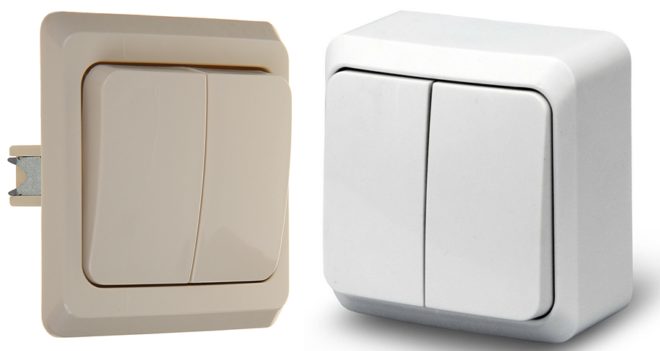
Fastening the wiring to the switch terminals
For installation in household lighting systems, only two types of wiring fasteners to the switch contacts are used - screw and screwless.
The screw connection is the standard, more familiar customary method of fastening when the wire is inserted into the terminal, which is bolted to the base. This method of fastening has one drawback - under the influence of an electric current, all conductors vibrate slightly, therefore, over time, such a connection may weaken, especially if the core is multi-wire.
A screwless connection is essentially a spring clamp - into which the wire is inserted and then fixed. The shape of the clamp prevents the core inserted in it from spontaneously falling out, and the spring neutralizes the vibrations caused by the current, therefore such a connection does not need to periodically tighten the contacts.
The disadvantages of screwless connections include the small contact area between the wire and the terminal and the fact that they are not designed for connecting aluminum wires.
In case of emergency, aluminum wires can still be used, but for this you will have to additionally buy a special lubricant, which must be used to cover the wires before fixing them in the clamps.

In practice, there is not much difference between the use of certain switches, since modern lighting devices have low power. Consequently, the current through the terminals is small and does not noticeably affect either the bolted connections or the terminals.
Method of inclusion
This is often the main criterion by which circuit breakers are selected. In addition to the differences in the internal filling, the connection method directly affects the design of the device - it will be universal, in a retro style or vice versa - in any of the modern trends.
Standard keyboards
This is the most common type of switch. They are made for external and internal wiring - they are distinguished by their simplicity of design and ease of use.The principle of operation is simplified as much as possible - inside such a device there is a mechanical two-position switch that closes or opens the electrical circuit.
Often, several lighting devices are turned on from one point - for example, it can be a toilet and a bathroom, or just different lamps on one chandelier, which requires several switches. In order not to clutter up the wall space, switches with two, three or more keys are made.

In turn, the following types of light switches can be attributed to this type:
Push-button
Their contacts act in tandem with a spring mechanism - when the button is pressed, they close, and when pressed again, the circuit is opened. Initially, such switches were installed on table lamps, and then such a mechanism began to be installed on wall models. In terms of cost, they are somewhat more expensive than standard key switches, but this is compensated by some non-standard solutions.
Rope
In fact, this is a slightly altered version of a push button switch - a lever is added to it, one arm of which presses the button, and a rope (chain) is connected to the other.
Most often, such devices are used as a design move, but they also have some practical advantages: they are much easier to find in the dark, and also easier for a child to reach.
Swivel
In principle, their electrical circuit is no different from keyboards - they also have only two positions, but the lighting is turned on and off after turning the handle on the case. They are rarely used, but they are still popular when creating retro-style open wiring. In contrast to two and three-key switches, the rotary switch is designed only in a single design.
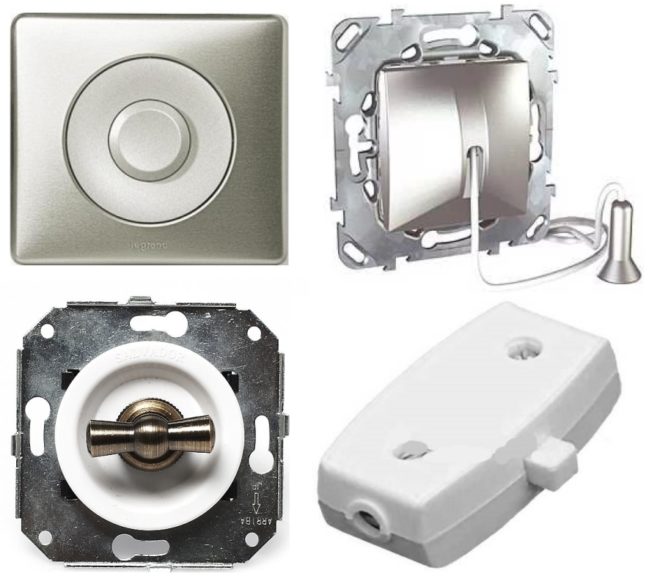
Slider
The simplest design - when you move the slider, the contacts are connected and the circuit is closed. When the slider moves back, the latch stops holding the contacts and they are disconnected under the action of a spring. For a number of reasons, they are used only to turn on portable devices - it is more practical to use other designs for stationary lighting.
Straight through switches
In fact, these are not switches, but two-position switches that close one or the second branch of the electrical circuit. The basis of their electrical circuit is three contacts: one at the input and two at the output - switching closes the incoming wire with one of the outgoing ones. The peculiarity of their design allows, when using two switches, to assemble a circuit in which one light source will be turned on and off from two different places.
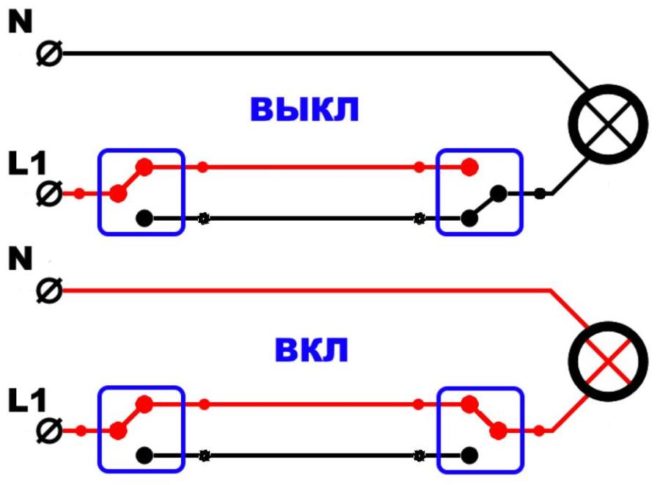
Outwardly, such switches are no different from standard keyboards, but there is one peculiarity in the way of switching on.
If ordinary ones have strictly marked on-off positions, then at the checkpoints they can constantly change.
For example, there are two switches, both keys are in the down position and the lights are off. When at the first point toggle the key up, the light will turn on. Then you need to turn off the lighting at the second point, for which the key on it also switches (from the lower position to the upper one). Now, to turn on the light at the first point, you must already lower the key to the "down" position, etc.
Cross (reversible)
Made for use in tandem with pass-through switches, in the event that it is necessary to turn on lighting from three or more places. The circuit of such a switch consists of four contacts - two at the input and two at the output. In one position, the incoming contacts are closed with the corresponding outgoing contacts (1 with 3, and 2 with 4), and when switching, they change places (1 goes to 4, and 2 to 3).
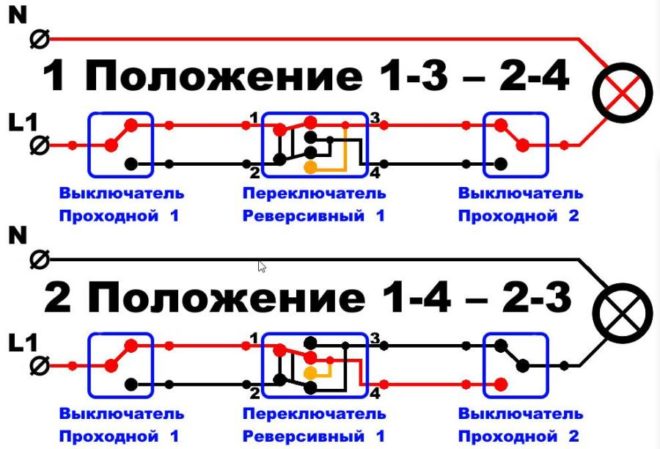
It can be seen from the diagram that, if necessary, the cross switch can be used as a conventional switch, but since its cost is slightly higher than the standard model, the feasibility of such a solution will be questionable.
Switches-dimmers (Dimmers)
The second name of such switches comes from the English word dimmer, which translates as dimming and fully characterizes the capabilities of this class of devices - a smooth change in the illumination level from maximum to complete shutdown.
In fact, it is a variable resistor that is installed in an electrical circuit in series with the load.
An example of the operation of such switches could be seen by every visitor of the cinema - when the light gradually starts to go out, it means that the film will begin now and it is necessary to take places as soon as possible, if they did not have time to do this in advance.
At home, such switches will be useful for setting the desired lighting intensity, because, for example, different brightness is needed for reading and watching TV.
Such a regulator will also be useful if the family has a small child who may be frightened by an unexpected change in lighting.
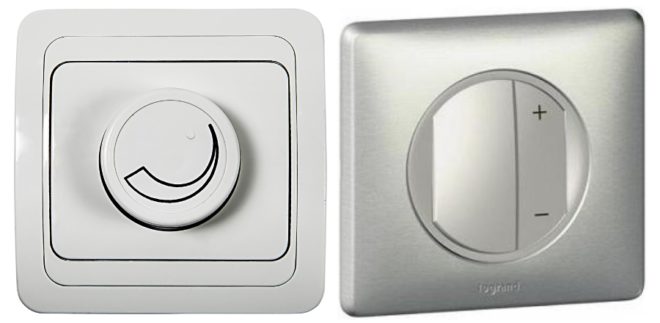
Sensory
These types of switches are made on the basis of two fundamentally different schemes. Initially, they used the presence of a certain electrical capacity in the human body - a capacitor circuit is used at the heart of such a device. After touching the contact, the capacitance changed and a signal was given to turn on or off the lighting. Even in the original version, such a light switch made it possible to smoothly adjust the illumination level - if you just touch the contact, the lamp turned off immediately, and if you hold your finger on the contact plate, then gradually.
Modern devices are equipped with miniature displays, like a mobile phone screen, and are controlled by means of a microcircuit. This allows you to add additional functions to such switches: timer, backlight, etc.
Acoustic
An interesting solution that allows you to turn on and off lighting from any part of the room without additional devices. Which device has such obvious disadvantages as an undoubted advantage, because of which it is recommended to consider the possibility of installing it in tandem with another switch.

Disadvantages include spontaneous triggering, for example, if you open champagne or just pat a child for a recited verse.
If the setting or placement of the switch is unsuccessful, then it will not always work the first time - this is especially the case for budget models.
It should also be borne in mind that sooner or later the light will have to be turned on silently, and also, such switches cannot regulate the illumination level.
Remotely controlled
These devices are one of the stages in the development of the "smart home" concept. After installing such switches, the lighting can be controlled using the remote control: turn on, turn off, dim - the full range of functions depends on the manufacturer.
Since all control is carried out both from the remote control and directly from the switch, the disadvantages of such a device are minimized, but they consist in the need to keep the remote control at hand and at the same time try not to sit on it and avoid other mechanical influences.
Obviously, the cost of such devices will be an order of magnitude higher than that of standard switches.
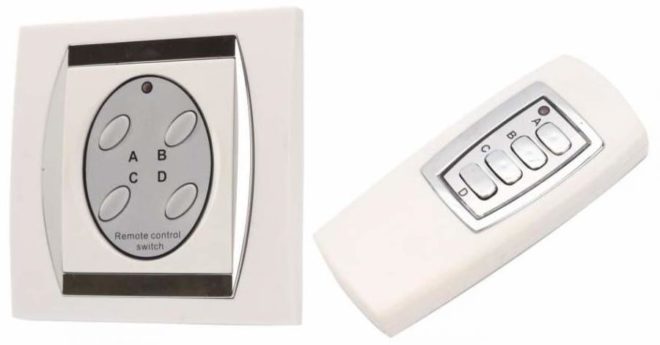
Additional functions
Smart home switches are not just limited to a remote control function - they are produced in a variety of variations, including the following:
Illuminated switches. It is very convenient to see where it is located if you go into a dark room. And just at night, the light will be a landmark, thanks to which you know which way to go, if the night light is not turned on. The disadvantage of such devices is the parallel connection of the LED - if the lighting device is a fluorescent lamp (or housekeeper) with a starter, then the capacitor will gradually charge through the LED. When it is fully charged, it will give the accumulated electricity to the lamp and it will glow for a short moment - this is usually very annoying.
Control switches. They are installed when the lamp is in one room, and the light switch itself is in another.There is a control lamp on the body that lights up together with the switched on lighting - this allows you to evaluate from afar, for example, if you forgot to turn off the light in the bathroom.

Timers switches. After a certain predetermined period of time after turning on, such a switch will turn off the light. Most commonly used in hallways, basements or toilets. Advanced models can give voice warnings that the lights are about to turn off.
Switches with motion sensor. They turn on the lighting when an object moves past them, which significantly saves electricity - the lamp does not shine all night, but for several minutes.
The disadvantage of budget models is that they are able to detect movement only in the perpendicular plane, and if you go directly to the sensor, it will assume that nothing is happening.
Switches with presence sensor. One of the most advanced models is capable of capturing infrared radiation, which always comes from a person, and on the basis of this determine that the room needs to be turned on. Accordingly, the light will not turn off while the person is in the room, so such a switch can be installed in the bedroom only if it is additionally equipped with a remote control.
What criteria should be used to choose a switch in the following video:
As a result, standard switches are far from all that the lighting market can offer. To make the right choice, you need to assess your needs and willingness to put up with the possible shortcomings that each type of household switches has. It is also worth remembering that these devices are installed for more than one year and there are not so many of them in the house. Therefore, if the budget issue is not too acute, then the savings on good switches are unlikely to be justified.




